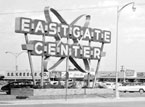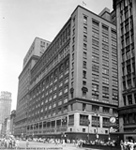
The Automobile Shapes The City
Suburban Communities
Historians David R. Goldfield and Blaine A. Brownell argued that "A new era of urbanization emerged after 1970, though few Americans noticed it at the time. Culminating a trend begun in 1920, the 1970 census announced that we had become a suburban nation." Core cities continued to lose population and see their economic base erode, becoming more specialized in the process. Metropolises developed multiple centers, including self-contained communities on the periphery, while non-metropolitan growth challenged traditional suburban expansion. Nationwide, Southern and Southwestern cities grew at the expense of older urban centers in the Northeast and Midwest.
The metropolitan complex was home to the majority of Americans after 1970. In 1975, 73 percent of the total United States population of 213 million lived in metropolitan counties; in 1988, 49 percent of the nation's population resided in "megalopolises" of one million or more. In 1990, of the total U.S. population of 248.7 million, 78.9 million (31.7 percent) lived in central cities; 79.4 million (31.9 percent) lived in the urban fringe; 28.8 million (11.6 percent) lived outside urbanized areas; and 61.7 million (24.8 percent) lived in rural areas. The 1990 census also indicated that California was the most urban state in the union at 93 percent, while the southern region had the largest metropolitan population (also the largest nonmetropolitan population). These patterns were part of the so-called Sunbelt movement. As historian Carl Abbott astutely observed, however, the growth of the Sunbelt was "essentially growth of sunbelt suburbs."
The well-accepted division between core city and suburban ring became more ambiguous (and even obsolete) in metropolitan areas. The old central city was only one of several activity centers. Numerous suburbs evolved into more than bedroom communities, some achieving the status of comprehensive communities with many of the amenities formerly located only at the core. Despite the anticipated return of some middle-class Americans to the central city through gentrification, population at the core continued to decline. Between 1970 and 1976, central city population dropped by 3.4 percent (to 60.7 million). In 1986, only about 30 percent of the American population lived in central cities; a disproportionate number were poor African Americans and poor Hispanics.
The central city essentially ceased to be the axis upon which the city turned in the late twentieth century. It did not disappear, but it often became the focus of a service economy dominated by banking, finance, medical, and educational institutions. As historian Jon Teaford rightly noted, the central city "had simply become one more suburb, yet another fragment of metropolitan America serving the special needs of certain classes of urban dwellers." Within the metropolis, increasing numbers of urbanites lived outside central cities and within what had conveniently been referred to as suburbs. By 1970 more than half of the metropolitan residents lived in suburban communities—including 20 to 40 percent of the poor in some areas. In 1980, the suburban portion of the 15 largest metropolitan areas ranged from 83.7 percent in Boston to 45.1 percent in Houston.
The term "suburb" became less and less useful in describing what was taking place on the urban fringe. The former bedroom communities that provided workers for the central cities were increasingly self-sufficient, attracting a bulk of the new jobs and many new business establishments, as well as cultural and recreational activities once reserved for downtown. By the 1980s, many former suburbs no longer depended on core cities. Commentators and scholars began to replace the old notion of suburbia with newer ideas—out towns, mall-towns, edge cities, and technoburbs.
From the mid-1930s onward, suburban communities themselves underwent physical changes and increasingly were planned, as Michael Berger suggested, “with the assumption that the car would be the major mode of transportation for their inhabitants.” The new highways as well as other technologies—septic tanks, longer range electrical transmission lines, and power-driven water pumps—made it practical for developers to buy up farmland for new subdivisions at great distances from metropolitan centers. Newer suburban communities also were designed for automobiles with stores, schools, churches, and recreational and cultural centers geared toward motorized transportation, not pedestrians—drive-in markets, drive-in movies, drive-in churches.
To the growing number of roadside businesses servicing the motorist was added the migration of retailers, office buildings, and industry away from the core to the periphery. Businesses migrated from central cities because of the deterioration of the cores, changes in the economic climate, the “greener pastures” that development along the urban periphery offered, and population shifts from rustbelt to sunbelt cities. In the 1930s, for example, Los Angeles’s downtown housed 75 percent of all retail trade; in the 1960s, only eighteen percent. By the end of the 1990s, two-thirds of all office space in the United States was located along the suburban fringe. The most dramatic changes took place in metropolitan areas, where suburban populations were the greatest and thus able to encourage business migration. In small cities whose population largely remained within the city limits, retail businesses often were more stable. The relocation of industry followed different patterns than retail business, and migration could be motivated by forces in addition to shifting demographic patterns or changes at the core. New industrial technologies sometime required more space—or different kinds of space—than core cities could offer. In some instances, businesses were able to purchase enough land to produce “landscrapers” instead of “skyscrapers.” Ameritech’s headquarters near O’Hare Airport outside of Chicago, for example, is more than one-half mile long. The impact of motor transport also favored decentralization of industry, since the new road systems allowed manufacturers to move freight by truck (and airplane) rather than by rail.
New shopping centers were automobile friendly, and the appearance of shopping malls with ample parking represented a clear commitment to motorized traffic by providing a concentration of shops on a scale only accessible by vehicles especially in areas where there was an absence of a commercial main street. The earliest shopping centers outside central business districts, such as the pioneering suburban shopping district in the Kansas City area, were built in the 1920s. There were, however, only eight of these centers in the whole country by the end of World War II. By 1970 the number had risen to an astonishing 4,000. Some older downtown department stores had been gigantic—Macy’s and Gimbles in New York, Marshall Field in Chicago, Foley’s in Houston—but in the newer suburban communities even grocery stores expanded impressively. The typical supermarket in the 1990s was around 60,000 square feet, with discount stores more than twice that size.
The idea of shopping malls—where more business could be conducted in one day than in the whole of a downtown area—grew up in the 1950s as a way to provide pedestrian shopping areas protected from the elements. In 1953 a shopping mall utilizing climate-control technology opened in Omaha City, Nebraska, with malls in Minneapolis (which claims it had the first true mall in 1956) and Detroit soon to follow. (Some claim that Lakewood Center near Long Beach, California, was among the earliest regional shopping malls built in the early 1950s.) In their turn, malls would go out of fashion and were replaced in some areas with mega-shopping areas incorporating several “superstores” or “big box” stores, like Wal-Mart, Home Depot, and Circuit City. Those retail establishments represented more than 80 percent of all new stores built in 1994. The automobile was still king even with the newer arrangements, however. The physical impact of these gigantic shopping areas was felt not only when they were thriving, but when they were abandoned as well.
Even suburban houses showed the presence of the automobile as early as the turn of the century. The driveway “became the entrance and exit ramp to domestic life,” replacing the front porch of a bygone age. In suburban houses, especially, the garage became an essential feature like the kitchen or living room. One observer called it an extension of the street or a buffer zone insulating the suburban dweller from the outside world, rather than simply a place to store a vehicle. This notion highlights the idea held by several scholars that suburban living epitomized—or overemphasized some would argue—the privatization of life.
Initially, cars might be stored in or adjacent to sheds, stables, and barns to keep them from the elements when not in use. Also, the garage often included workspace since the early cars were maintained by their owners. It was common to refer to these early garages as an “automobile house,” but the term “garage,” from the French word for “to shelter,” caught on as the standard name—and one that confirmed the automobile’s important role as a prized possession, not an animate object. After all, cars needed protection not only from the elements but from fire, theft, and vandalism. In the 1920s, the garage often was attached—or semi-attached—to the house for a number of reasons: reducing the overall cost of construction, providing easy access to the house, freeing space in the backyard, and increasing the overall size of the house. In the post-World War II era, open carports were added to some houses, especially where climate was not such a key factor in protecting cars from the cold, and in cases where homeowners saw them as adding to the modern aesthetic of their home. The advent of the multi-car family and changing styles and needs eventually reduced interest in building carports. But whether a house had a garage or a carport, the automobile was built into the design of many homes and into the culture of the families who owned them. One observer concluded, “The garage’s evolution from backyard shed to front entrance clearly reveals the impact of the car on domestic space.”
From the intimacy of the suburban home to the expansiveness of the freeway system, the automobile is an integral part of the modern American landscape. The symbiosis between the car and the city became so seamless in the twentieth century that, in many cases, people are unaware of the powerful historic forces that helped to blend car and environment. When we think about the relationship between the automobile and our surroundings, it is probably easiest to conjure up images of traffic and congestion or grave apprehension over ubiquitous smog. It is easy to forget, on the other hand, how motorized vehicles have contributed to the very shape, tone, and texture of our society.
<<Previous Section - Next Section>>
Introduction
The “Footprint” of the Automobile on the American City
From “Walking Cities” to “Automobile Cities"
Filling Stations and Other Services
Expressways, Freeways, and Superhighways
Suburban Communities
Complete Text Printable View
older downtown department stores
About the Project | Credits | Contact Us | Student & Teacher Resources | Site Map
©2004-2010 Automobile in American Life and Society



